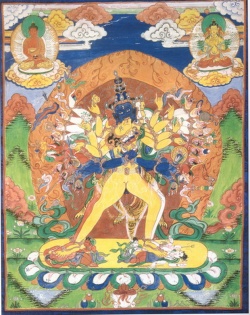Kālacakrapāda the Elder
The one known as Kālacakrapāda the Elder (dus zhabs pa chen po) was born in Varendra (a region of northern Bengal) in eastern India. His father was a Brahmin yogin who practised Black Yamāri (gshin rje gshed nag po), and his mother was an awareness ḍākinī. They performed a ritual from the Kṛiṣṇayamāri Tantra to ensure the birth of a noble son. The father dreamed of the noble Mañjuśrī entering his wife's belly, and the child was later born together with auspicious signs.
Due to the blessing of noble Mañjuśrī the child had a bright mind with clear faculties, and took ordination when he was young. He studied many subjects and understanding them all with ease he became a paṇḍita and was known as Cilupa. He heard of Kālacakra from Paṇḍita Ācārya, but was not satisfied, and through the awakening of his previous prayers he developed a powerful wish to go to Sambhala. As his personal deity Tārā would grant the realization of anything he wished, she prophesied that for the benefit of beings he would gather from Sambhala many tantras and bodhisattva commentaries.
This is a reference to a particular cycle of commentaries, often known as the bodhisattva trilogy (sems 'grel skor gsum). Said each to have been written by great bodhisattvas, one is the Vimalaprabhā commentary on Kālacakra, and the other two deal with the Cakrasaṃvara and Hevajra tantras.
He travelled to the north, but as there was physical danger due to a desolate area that would need four months to cross, he traveled together with some traders by boat across an ocean. The traders went to an island of jewels, and he traveled on to the north. He climbed a mountain on an island in the ocean, and there met a white man, who was an emanation of the Kalkī king of Sambhala. Some say this was the king Śrīpāla and others say it was Puṇḍarīka.
The king asked him where he was going and for what reason. He replied that he had traveled from eastern India and was on his way to Sambhala to meet the Kalkī and request teachings on Kālacakra. The king told him that he would not be able to make such a journey, but that if he could understand such things here, would he not listen?
Cilupa then understood that the man was an emanation of the kalkī and prostrated to him and circumambulated him many times. After offering a maṇḍala, he requested that he accept him as a student. The king told him "I have come here in order to teach you Kālacakra for the benefit of beings in India, so listen."
He then manifested the complete Dharmadhātu maṇḍala and gave him empowerment. This is presumably a reference to the Dharmadhātuvāgīśvaramaṇḍala (chos dbyings gsung gi dbang phyug gi dkyil 'khor), a name of the usual triple Kālacakr maṇḍala. He gave him instruction in the very fast path of the profound six-limbed yogas.
Cilupa meditated for seven days at the foot of the mountain by the side of the ocean and attained realization. He magically flew through the air to the Māla grove in Sambhala, and there, at the Kālacakra maṇḍala house, he bowed to the feet of the Kalkī in person, who gave him the complete empowerment, explained to him the instructions on the tantra and commentary, and gave him texts of the bodhisattva teachings: the Laghutantra, the Kālacakra Tantrottara, the Vimalaprabhā, the Mūlatantra, the Sekoddeśa, the Triyogahṛidayavyākara, the Paramārthasevā, the Cakrasaṃvara Piṇḍārtha commentary and the Vajragarbha commentary on Hevajra.
e then travelled to Puṣpagiri (me tog khyim) in eastern India, and after travelling to Magadha, Cilupa became known as Kālacakrapāda the Elder. He spread the teachings of the bodhisattva cycle widely through east and west India.
Kālacakrapāda the Elder had many students, among whom were three known as Kālacakrapāda the Younger: Avadhūtipa, Śrībhadrabodhi and Nālandāpa; also Nāropa, Sādhuputra, Ratnakaragupta, Mokṣakaragupta, Vinayākaramati, Siṃhadhvaya and Anantajaya.
